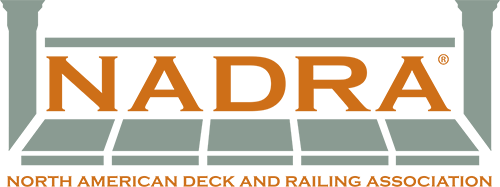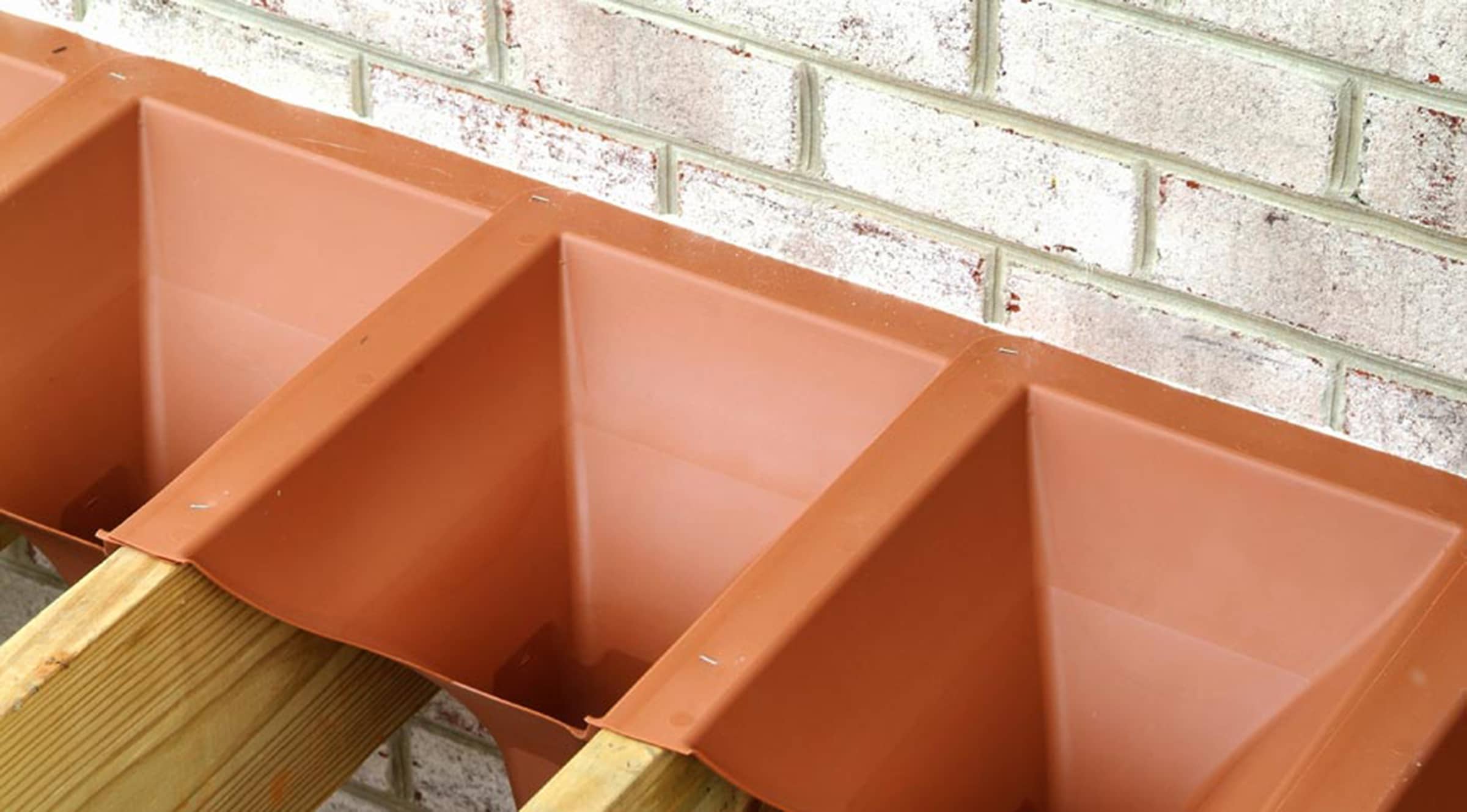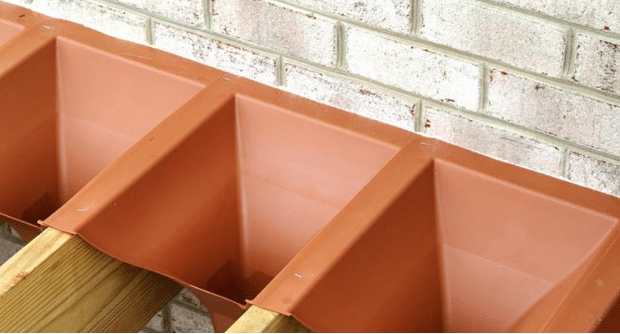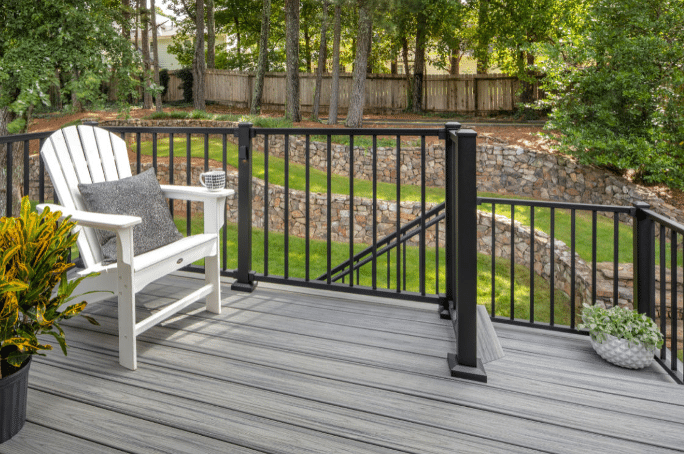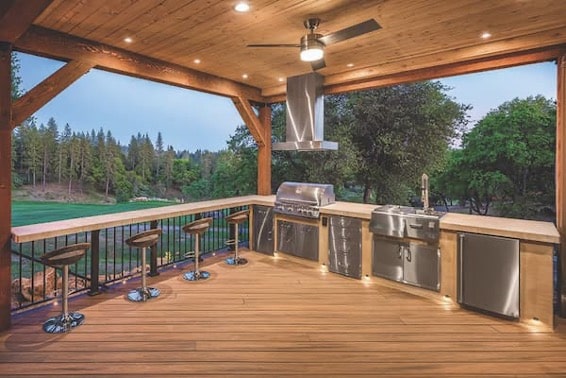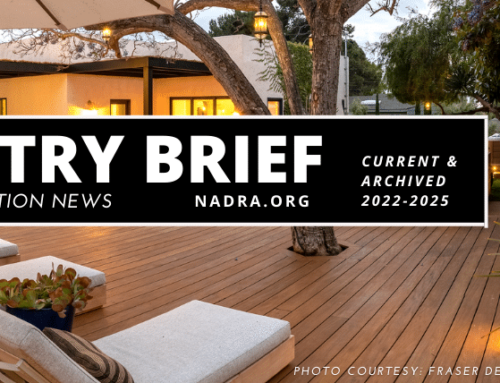It is well known amongst professional builders that water is the leading cause of deterioration for decks. It can lead to mold, mildew, rot and premature deck failure. Although there is no off-the-shelf raincoat for decks, there are a number of waterproofing techniques and products available to protect a deck from water penetration and damage. Following are five steps to prevent water from undermining your next installation:
1. Assess the site.
Survey the slope/grade of the surrounding landscape. Water must drain away from the building and deck structure. Set the deck framing at a pitch of 1% to 2% (1/8” to 1/4” per foot) to slope away from the building. If you plan to install an under-deck drainage system, like Trex® RainEscape®, decide where the water will discharge. Consider adding a French drain (a.k.a. an engineered trench), reservoir or other means to redirect the water or collect it for use in watering a garden or planting area.
Using a network of troughs and downspouts, the Trex RainEscape system captures and diverts water away from a deck, creating a dry, usable space beneath the deck.
2. Protect the substructure.
The lumber used in deck beams, joists and stair stringers is pressure-treated to be water-resistant – not waterproof. To protect these structural elements from moisture and rot, it’s critical to apply flashing tape over all the joinery and blocking. It’s easy to do and is an inexpensive way to preserve the structure’s performance and integrity.
Flashing tape comes in asphalt, acrylic or butyl formulations. Asphalt tapes are inexpensive, but they’re difficult to handle without making a mess, especially in hot weather. Acrylic tapes are more expensive and take 24 to 72 hours to fully set. Butyl tapes strike an optimal balance. They don’t ooze like asphalt and they set faster than acrylic tapes. Whatever flashing tape you use, be sure it meets or exceeds the requirements of AAMA 711-13. (The requirements for deck flashing are outlined in section R703.4 of the International Residential Code).
Flashing tape is also an excellent option for protecting the ledger board from moisture damage. A superior alternative to traditional metal or vinyl flashing, flashing tape provides a waterproof seal that is fully compatible with pressure-treated lumber. Trex Seal, for example, offers the best of both worlds. The 11”-wide butyl-based tape is designed to cover the entire ledger board and is engineered with an aluminum lining that gives the tape “memory” so it can be shaped to fit inside difficult corners.
For concrete decks or decks sheathed in plywood, over-deck sheet membranes are another option for moisture protection. These vinyl sheets offer excellent waterproofing but cannot be used over wood or composite deck boards. In addition, the seams must be carefully sealed to prevent leaks, sometimes using proprietary equipment.
3. Use low-maintenance decking.
Wood decks can be beautiful but any wood, whether pressure-treated lumber, cedar or exotic hardwood, must be cleaned regularly and coated every few years to keep it looking good and to prevent water damage. That’s why composite and PVC boards, which are practically impervious to water, continue to gain popularity. They require little upkeep and last for decades. An occasional soap-and-water cleaning is typically all that’s needed to clean up spills and debris, leaving homeowners more time to enjoy their outdoor spaces.
Low-maintenance decking materials, such as composite and PVC, continue to gain popularity among today’s homeowners.
4. Don’t forget the space beneath the deck.
With elevated decks, the area underneath the deck surface can add tremendous value as a bonus storage area or additional outdoor living space. For waterproofing, there are a couple of options.
Decking flanges are rubbery gaskets that compress between deck boards to prevent water from passing through. With profiles tailored to fit most major brands of composite decking, these flanges eliminate the need for under-deck drainage because the water runs off the deck surface, not through it. Flanges also keep joist bays dry, simplifying the addition of living space below.
One potential drawback to deck flanges, however, is that you cannot use hidden fasteners since they would interfere with the seal between boards. Instead, boards must be face-screwed. Flanges also require specialized tools and installation techniques.
For optimal aesthetics and protection, most deck builders prefer to use an under-deck drainage system to steer water away from a deck and keep the area underneath dry and usable. Drainage systems installed above the joists offer more protection than systems that use below-joist panels because they prevent water from coming into contact with the joists and fasteners. By contrast, below-joist panels can trap moisture in the joist bays, accelerating deterioration. With the benefit of dry joists and joist bays, an over-the-joist drainage system makes installing lights, fans and other electrical accessories beneath the deck simple. If you plan to enclose the below-deck area, it’s a good idea to add an access panel to accommodate periodic inspection of the drainage system and structural elements.
An above-the-joist drainage system, like Trex RainEscape, makes installing lights, fans, and other electrical components simple.
5. Consider other sources of moisture.
It’s not only rain and snow that can threaten decks. Consider the following moisture sources and take preventative measures where necessary.
- If any eaves overhang the deck, be sure to redirect the runoff with a gutter. Otherwise, over time, the dripline may leave stains on the deck boards.
- Direct sprinkler heads so they water plants and flowers – and not the deck.
- Keep trees and shrubs from contacting or crowding the deck to ensure good airflow in and around the deck and structure.
- Tree litter.Trim or remove large limbs or branches that extend over the deck. This will reduce the amount of tree litter that accumulates on the deck. With less debris, there will be less trapped moisture. Removal also means no large branches that can break off in a storm and damage the deck.
Most homeowners are comfortable paying a little extra for a waterproof deck. If not, point out the long-term cost savings and peace of mind that come with it. Show them photos of decks that have suffered from water damage and explain how waterproofing techniques can prevent these issues. Highlight product warranties and the enhanced performance and value to help customers justify the marginally higher cost of waterproofing.
For more waterproofing tips, visit TrexRainEscape.com.
# # #
About the Author
Kile is CEO of IBP, LLC, which owns and licenses Trex RainEscape and Trex Protect. For more information visit trexrainescape.com and trexprotect.com.
